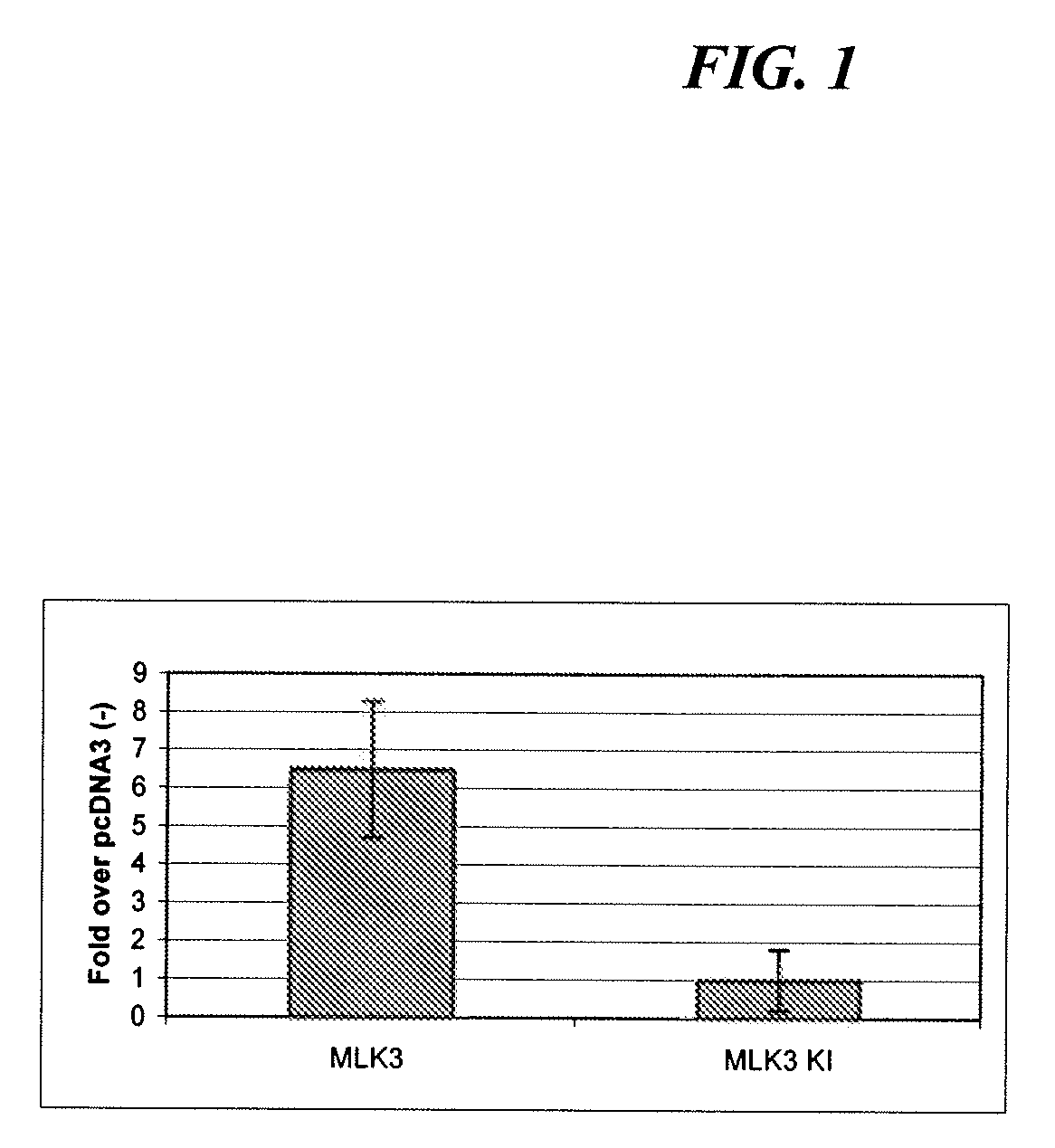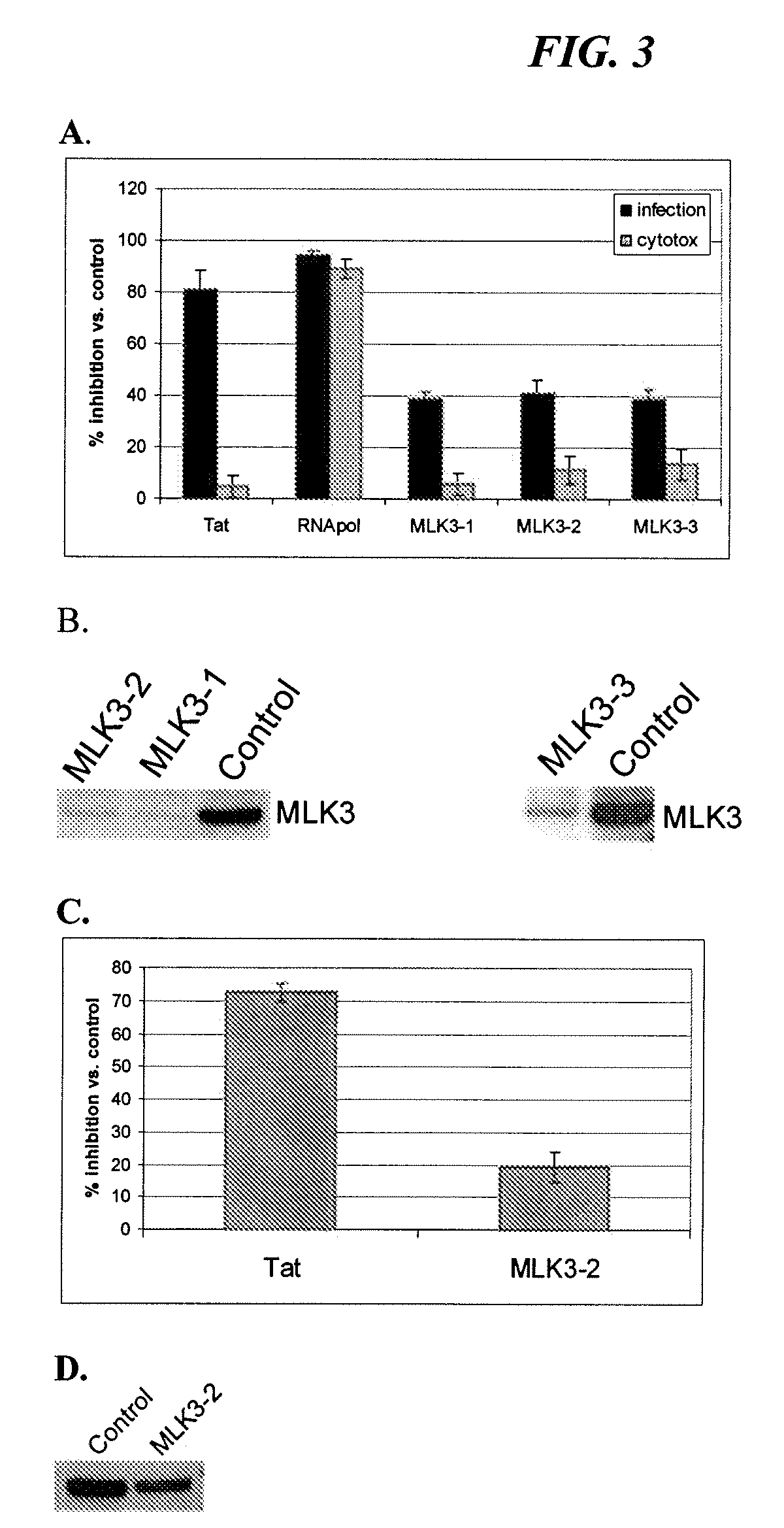Methods and compositions for inhibiting HIV infection
- Summary
- Abstract
- Description
- Claims
- Application Information
AI Technical Summary
Benefits of technology
Problems solved by technology
Method used
Image
Examples
example 1
General Materials and Methods
[0076]Cells lines and maintenance: HeLaCD4βgal cells from Dr. Michael Emerman were obtained through the AIDS Research and Reference Reagent Program, Division of AIDS, NIAID, NIH (Kimpton, J. Virol. 66:2232-9, 1992). The cells were maintained in DMEM supplemented with 10% FBS, 1× Penicillin / Streptomycin / L-glutamine, 0.2 mg / mL G418 and 0.1 mg / mL Hygromycin B. Jurkat cells were maintained in RPMI-1640 supplemented with 10% FBS and 1× Penicillin / Streptomycin / L-glutamine. All cell culture reagents were obtained from Invitrogen.
[0077]cDNA screening in HeLaCD4βgal cells: High throughput cDNA retro-transfection of HeLaCD4βgal cells was carried out essentially as described in Chanda et al., Proc. Natl. Acad. Sci. USA 100:12153-8, 2003. Briefly, individual cDNA of a sub-genomic library encompassing 15,000 genes (collection details at http: / / function.gnf.org), negative control Sport6GFP cDNA and positive control Sport6-Tat plasmid were spotted at 40 ng / well in 55 w...
example 2
Identification of Novel HIV-Interacting Host Factors from siRNA Screening
[0083]We performed a sub-genomic siRNA screen for host proteins that are involved in HIV infection by monitoring expression of a reporter gene under the control of HIV LTR promoter in HeLaCD4Bgal cells (Kimpton et al., J Virol 66:2232-2239, 1992). The HeLa-CD4-Bgal cells were obtained from Dr. Michael Emerman through the AIDS Research and Reference Reagent Program, Division of AIDS, NIAID, NIH. The cells were transfected using a reverse transfection protocol with siRNA against Tat used as a positive control and were challenged with HIV-IIIb 24 hours after transfection (Huang et al., Proc. Nat. Acad. Sci. U.S.A. 101:3456-61, 2004). Infection was allowed to proceed for 3 days to allow for effects on all stages of infection from entry to release and spread throughout the culture to be seen. By monitoring reporter gene expression in the HeLa-CD4-Bgal cells, this system allows one to detect any modulating effect of ...
example 3
Identification and Characterization of HIV-Interacting Host Factors from cDNA Screening
[0085]We performed a high-throughput screen of a cDNA library of 15,000 unique genes to find novel pro-viral factors whose overexpression would lead to enhancement of HIV-IIIb infection. Because of their ease of transfection, we employed HeLaCD4βgal cells for screening and challenged with replication competent HIV-IIIb. Negative control (Sport6-gfp) and positive control (Tat-Sport6) cDNAs were spotted into wells of 384-well plates containing the library cDNA (one gene per well) followed by the addition of transfection reagent solution containing an LTR-luciferase reporter construct responsive to HIV Tat. Cells were added after complex formation, and after 24 hours, each well was infected with HIV-IIIb. Infection was allowed to proceed for 3 days to allow for effects on all stages of infection from entry to release and spread throughout the culture to be observed. Infection was then assessed by mea...
PUM
| Property | Measurement | Unit |
|---|---|---|
| Fraction | aaaaa | aaaaa |
| Fraction | aaaaa | aaaaa |
| Fraction | aaaaa | aaaaa |
Abstract
Description
Claims
Application Information
 Login to View More
Login to View More - R&D
- Intellectual Property
- Life Sciences
- Materials
- Tech Scout
- Unparalleled Data Quality
- Higher Quality Content
- 60% Fewer Hallucinations
Browse by: Latest US Patents, China's latest patents, Technical Efficacy Thesaurus, Application Domain, Technology Topic, Popular Technical Reports.
© 2025 PatSnap. All rights reserved.Legal|Privacy policy|Modern Slavery Act Transparency Statement|Sitemap|About US| Contact US: help@patsnap.com



